Is HPMC a surfactant?
Is HPMC a surfactant?
HPMC, or Hydroxypropyl Methylcellulose, is not a surfactant in the strictest sense of the term. Surfactants are molecules that have both hydrophilic (water-loving) and hydrophobic (water-repelling) ends, and they are used to reduce the surface tension between two immiscible liquids or between a liquid and a solid. Surfactants are commonly used in a wide range of industries, including cleaning products, personal care products, and pharmaceuticals, among others.
On the other hand, HPMC is a cellulose-based polymer that is used in a variety of applications, including pharmaceuticals, food, and personal care products, among others. HPMC is produced by chemically modifying cellulose, which is a natural polymer found in plants. Specifically, HPMC is produced by substituting some of the hydroxyl groups in cellulose with either methyl or hydroxypropyl groups. The resulting polymer is water-soluble and can be used as a thickener, binder, emulsifier, and stabilizer, among other functions.
Despite not being a surfactant, HPMC can exhibit surfactant-like properties in certain applications. For example, HPMC can be used to stabilize emulsions, which are mixtures of two immiscible liquids, by forming a protective layer around the droplets of one liquid in the other liquid. This layer can prevent the droplets from coalescing and separating from the rest of the mixture. In this way, HPMC can function as an emulsifier, which is a type of surfactant.
In addition, HPMC can be used to reduce the surface tension of water, which is a property of surfactants. For example, HPMC can be used as a coating on solid surfaces to make them more hydrophilic, which can increase their wetting properties. In this application, HPMC can reduce the surface tension of water on the coated surface, which can improve the adhesion of liquids or solids to the surface.
Overall, while HPMC is not a surfactant in the strictest sense of the term, it can exhibit surfactant-like properties in certain applications. HPMC is a versatile polymer that can be used in a wide range of industries, and its unique properties make it a valuable ingredient in many formulations.
